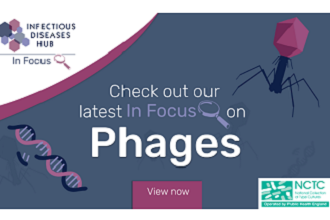Bacteriophage Collection from NCTC
Wednesday 13 January
Bacteriophage Collection from NCTC - eBook
Bacteriophages have been attracting increasing levels of attention from both scientists and the mainstream media in recent years. This is due to their potential role in the treatment of bacterial infections (phage therapy). Phage therapy is not a new phenomenon; it was first described over 100 years ago, when its applications were used widely, particularly in Eastern Europe. The rise of antimicrobial resistance combined with several high-profile cases of successful phage therapy, when all other treatment options had been exhausted, has once again re-engaged interest in this approach.
As the application of phages for potential solutions to bacterial problems grows, having a repository from which scientists can both source and deposit bacteriophages is essential. The National Collection of Type Cultures (NCTC) is the world’s oldest bacterial strain collection and has recently established a bacteriophage repository, which aims to provide a trustworthy source of authenticated phages.

Bacteriophage eBook
In collaboration with ID Hub, NCTC have a number of online bacteriophage resources about the NCTC phage collection which include an infographic and video, and a podcast with NCTC Curator, Dr Sarah Alexander, and Molecular Microbiologist Juandem Agendia all of which are available through an eBook.
The collection contains over 100 Staphylococcus, Streptococcus and Campylobacter bacteriophages which were deposited between 1950 and 1992, primarily for their value in bacterial typing. Recently, these have been characterised and re-authenticated in order to make them accessible to scientists worldwide.
The NCTC bacteriophage collection is a dynamic collection, representing a repository into which microbiologists can also deposit phages, which in turn will support accessibility and reproducibility in science.
A fresh look at last century’s phages
The NCTC in England has freshly re-characterized 100 phages originally collected for bacterial typing in the 1950s-1990s. If you want your phages to last as long as these, this is a great place to deposit!
A two-year journey to re-characterize old phages: Juandem’s perspective
What a journey it has been with NCTC since June 2018! I have thoroughly enjoyed getting acquainted to the phages within this collection and it feels so good to be able to share this unique resource with the scientific community. When I got this job offer to re-authenticate the bacteriophages in the NCTC collection, I genuinely felt like I would be working in a museum of sorts.
On my first day, I got to see the ampoules and was very excited when I opened my first one a few weeks later. I had my own ideas of what I expected but it was not plain sailing all the way. It took me a good month at least to see my first plaques in the lab! Every phage biologist understands the exhilarating feeling that comes with. The more challenges I found, the more drive I had to keep going. Another high was doing the imaging via electron microscopy. This actually was like meeting your baby for the first time. Even more exciting was the move to launch these phages to the public at Phage Futures Europe in 2019 and establishing some contacts which have ultimately led to our first external deposition which we have only just begun to unfold.
Despite the turbulence this past year, I am even more determined to do more to make this collection as dynamic and open to scientists as possible. I truly believe that the road ahead is full of exciting stops and I cannot wait to see where that will lead me.
Click here to read more about the NCTC phage collection relaunch